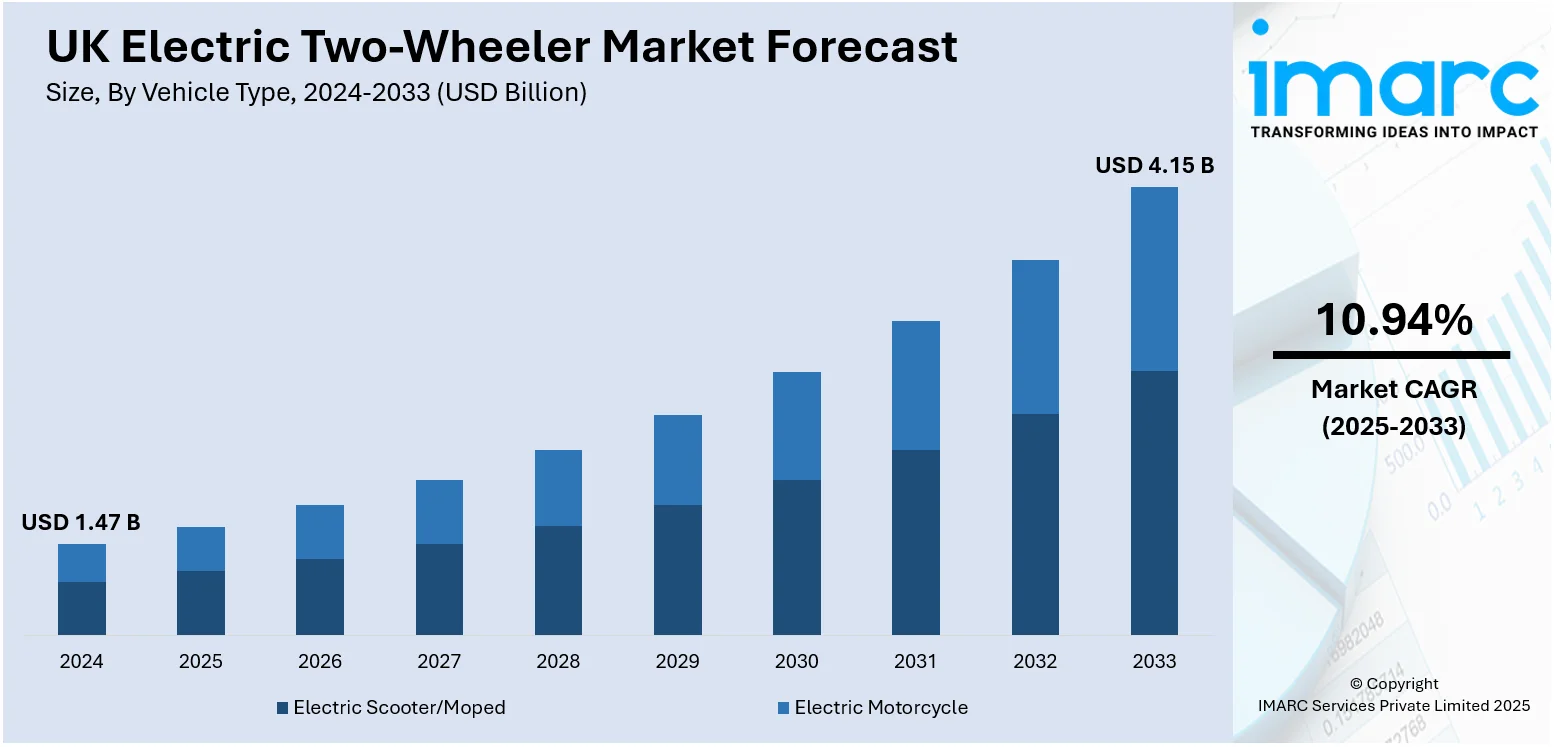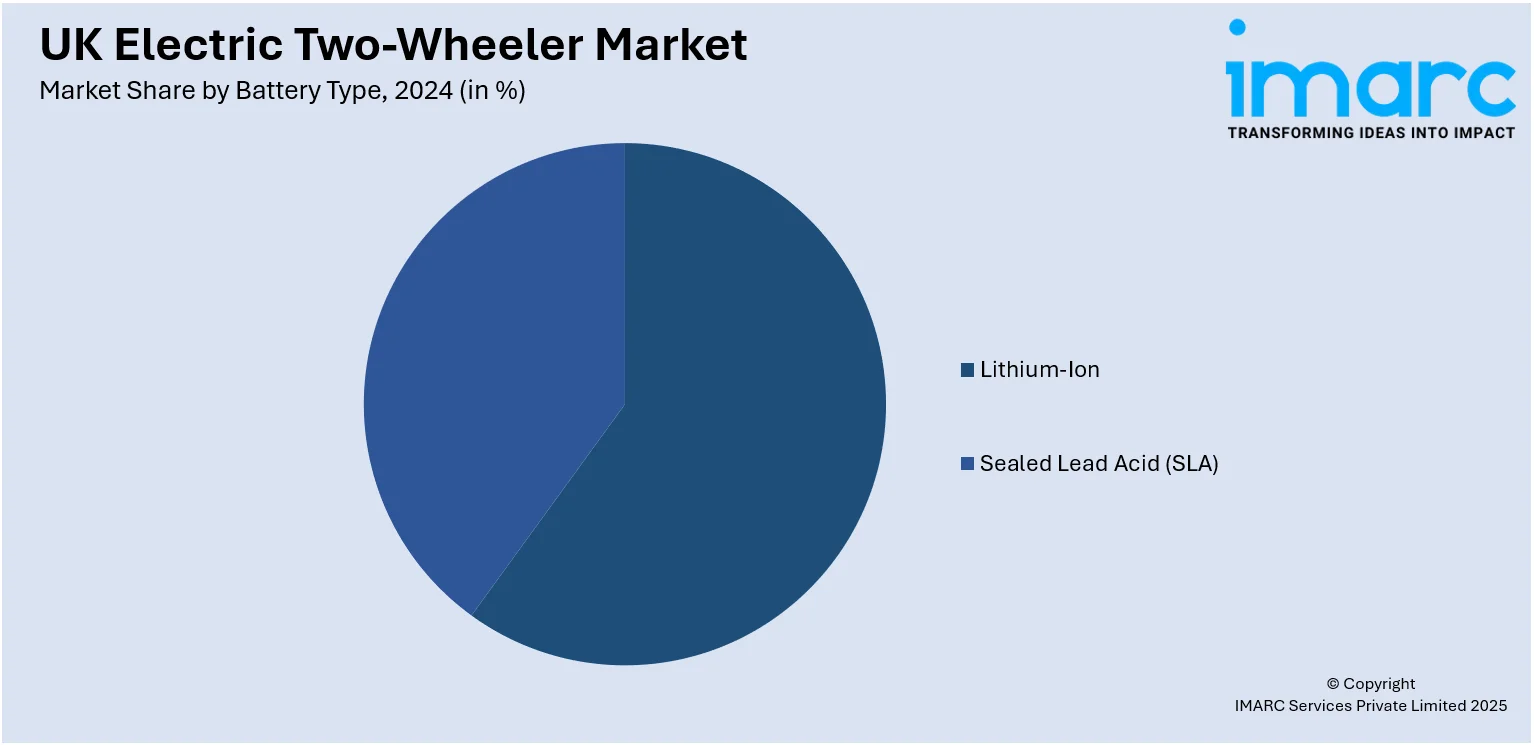
UK Electric Two-Wheeler Market Size, Share, Trends and Forecast by Vehicle Type, Battery Type, Voltage Type, Peak Power, Battery Technology, Motor Placement, and Region, 2025-2033
UK Electric Two-Wheeler Market Overview:
The UK electric two-wheeler market size reached USD 1.47 Billion in 2024. The market is projected to reach USD 4.15 Billion by 2033, exhibiting a growth rate (CAGR) of 10.94% during 2025-2033. The market is driven by rising environmental awareness, government incentives such as grants under the Plug-in Motorcycle Grant scheme and increasing adoption of low-emission zones in cities. Consumers are moving toward more economical, environmentally friendly mobility options as a result of rising gasoline prices and traffic fees. Advancements in battery technology, offering longer ranges and faster charging, enhance appeal, while shared mobility services and e-scooter rental schemes further boost UK electric two-wheeler market share. Supportive infrastructure development and sustainability-focused policies strengthen market growth prospects.
|
Report Attribute
|
Key Statistics
|
|---|---|
|
Base Year
|
2024
|
|
Forecast Years
|
2025-2033
|
|
Historical Years
|
2019-2024
|
| Market Size in 2024 | USD 1.47 Billion |
| Market Forecast in 2033 | USD 4.15 Billion |
| Market Growth Rate 2025-2033 | 10.94% |
UK Electric Two-Wheeler Market Trends:
Government Policies & Incentives
Adoption of electric two-wheelers through supportive policies and incentives is one of the prominent UK electric two-wheeler market trends. The Plug-in Motorcycle Grant offers discounts on eligible electric motorcycles and scooters, reducing upfront costs for consumers and businesses. In addition, initiatives such as tax benefits for zero-emission vehicles and reduced registration or road tax fees further enhance affordability. The expansion of Clean Air Zones (CAZ) and Ultra Low Emission Zones (ULEZ), particularly in cities like London, encourages commuters and delivery companies to shift towards electric alternatives to avoid penalties and extra charges. Programs for infrastructure development, such parking incentives and charging stations specifically for EVs, are also being introduced by local councils. These combined measures not only lower ownership costs but also make electric two-wheelers more practical and attractive for both personal and commercial use.

To get more information on this market, Request Sample
Advancements in Battery & Charging Technology
Technological advancements in battery and charging solutions are aiding the UK electric two-wheeler market growth. Modern lithium-ion batteries now deliver higher energy density, extending range and making electric scooters and motorcycles suitable for both short commutes and longer trips. Rapid charging technology further reduces downtime, with some models supporting partial charges within minutes—an essential feature for urban users. Swappable battery systems are also emerging, especially for fleet operators, enabling continuous operations without delays. Supporting this progress, public charging infrastructure has grown rapidly; as of July 1, 2025, the UK had 82,002 public charging devices across 30,169 on-street and 40,109 destination locations—a 27% increase in one year. These advancements, coupled with decreasing battery costs, are making electric two-wheelers more practical, reliable, and affordable, strengthening their role as a sustainable alternative to petrol-powered options.
Rising Fuel Prices & Urban Mobility Challenges
Escalating fuel prices in the UK affect daily commuters and last-mile delivery operators immensely and hence make electric two-wheelers the desirable option considering their cheaper running and servicing costs. With petrol and diesel prices fluctuating at record levels, electric scooters and motorbikes are an affordable way of transport, particularly for short commutes within cities. Additionally, rising congestion in big cities boosts the demand for small, nimble cars that can easily move on congested urban roads. Congestion charges introduced in cities such as London further encourage the adoption of zero-emission transport, enabling users to save money on extra charges. For delivery operations, especially in the fast-growing e-commerce and food delivery industries, electric two-wheelers provide efficiency in running operations and cost savings. Collectively, these logistical and economic drivers fuel the movement toward sustainable, accessible, and convenient electric mobility in cities.
UK Electric Two-Wheeler Market Segmentation:
IMARC Group provides an analysis of the key trends in each segment of the market, along with forecasts at the country and regional levels for 2025-2033. Our report has categorized the market based on vehicle type, battery type, voltage type, peak power, battery technology, and motor placement.
Vehicle Type Insights:
- Electric Scooter/Moped
- Electric Motorcycle
The report has provided a detailed breakup and analysis of the market based on the vehicle type. This includes electric scooter/moped and electric motorcycle.
Battery Type Insights:

- Lithium-Ion
- Sealed Lead Acid (SLA)
A detailed breakup and analysis of the market based on the battery type have also been provided in the report. This includes lithium-ion and sealed lead acid (SLA).
Voltage Type Insights:
- <48V
- 48-60V
- 61-72V
- 73-96V
- >96V
A detailed breakup and analysis of the market based on the voltage type have also been provided in the report. This includes <48V, 48-60V, 61-72V, 73-96V, and >96V.
Peak Power Insights:
- <3 kW
- 3-6 kW
- 7-10 kW
- >10 kW
A detailed breakup and analysis of the market based on the peak power have also been provided in the report. This includes <3 kW, 3-6 kW, 7-10 kW, and >10 kW.
Battery Technology Insights:
- Removable
- Non-Removable
A detailed breakup and analysis of the market based on the battery technology have also been provided in the report. This includes removable and non-removable.
Motor Placement Insights:
- Hub Type
- Chassis Mounted
A detailed breakup and analysis of the market based on the motor placement have also been provided in the report. This includes hub type and chassis mounted.
Regional Insights:
- London
- South East
- North West
- East of England
- South West
- Scotland
- West Midlands
- Yorkshire and The Humber
- East Midlands
- Others
The report has also provided a comprehensive analysis of all the major regional markets, which include London, Southeast, North West, East of England, South West, Scotland, West Midlands, Yorkshire and The Humber, East Midlands, and others.
Competitive Landscape:
The market research report has also provided a comprehensive analysis of the competitive landscape. Competitive analysis such as market structure, key player positioning, top winning strategies, competitive dashboard, and company evaluation quadrant has been covered in the report. Also, detailed profiles of all major companies have been provided.
UK Electric Two-Wheeler Market News:
- In July 2025, Hero MotoCorp is set to enter the UK, Germany, France, and Spain with its all-electric Vida sub-brand this September, starting with the Vida Z scooter unveiled at EICMA 2024. The move highlights Hero’s global expansion and focus on sustainable mobility. Following this, premium ICE models like the Xtreme 250R and XPulse 421 will join its European lineup, strengthening Hero’s position in premium and electric motorcycle markets worldwide.
- In June 2025, Bengaluru-based Ultraviolette launched its F77 electric motorcycles across ten European countries, including the UK, Germany, France, and Italy. Revealed at a Paris event, the F77 MACH 2 and F77 SuperStreet feature a 10.3 kWh battery, 30 kW peak power, 100 Nm torque, 0–60 km/h in 2.8 seconds, and a top speed of 155 km/h. Equipped with Violette A.I., Bosch dual-channel ABS, traction control, regenerative braking, and dynamic stability control, the models target performance and comfort for European riders.
UK Electric Two-Wheeler Market Report Coverage:
| Report Features | Details |
|---|---|
| Base Year of the Analysis | 2024 |
| Historical Period | 2019-2024 |
| Forecast Period | 2025-2033 |
| Units | Billion USD |
| Scope of the Report |
Exploration of Historical Trends and Market Outlook, Industry Catalysts and Challenges, Segment-Wise Historical and Future Market Assessment:
|
| Vehicle Types Covered | Electric Scooter/Moped, Electric Motorcycle |
| Battery Types Covered | Lithium-Ion, Sealed Lead Acid (SLA) |
| Voltage Types Covered | <48V, 48-60V, 61-72V, 73-96V, >96V |
| Peak Powers Covered | <3 kW, 3-6 kW, 7-10 kW, >10 kW |
| Battery Technologies Covered | Removable, Non-Removable |
| Motor Placements Covered | Hub Type, Chassis Mounted |
| Regions Covered | London, Southeast, North West, East of England, South West, Scotland, West Midlands, Yorkshire and The Humber, East Midlands, others |
| Customization Scope | 10% Free Customization |
| Post-Sale Analyst Support | 10-12 Weeks |
| Delivery Format | PDF and Excel through Email (We can also provide the editable version of the report in PPT/Word format on special request) |
Key Questions Answered in This Report:
- How has the UK electric two-wheeler market performed so far and how will it perform in the coming years?
- What is the breakup of the UK electric two-wheeler market on the basis of vehicle type?
- What is the breakup of the UK electric two-wheeler market on the basis of battery type?
- What is the breakup of the UK electric two-wheeler market on the basis of voltage type?
- What is the breakup of the UK electric two-wheeler market on the basis of peak power?
- What is the breakup of the UK electric two-wheeler market on the basis of battery technology?
- What is the breakup of the UK electric two-wheeler market on the basis of motor placement?
- What is the breakup of the UK electric two-wheeler market on the basis of region?
- What are the various stages in the value chain of the UK electric two-wheeler market?
- What are the key driving factors and challenges in the UK electric two-wheeler market?
- What is the structure of the UK electric two-wheeler market and who are the key players?
- What is the degree of competition in the UK electric two-wheeler market?
Key Benefits for Stakeholders:
- IMARC’s industry report offers a comprehensive quantitative analysis of various market segments, historical and current market trends, market forecasts, and dynamics of the UK electric two-wheeler market from 2019-2033.
- The research report provides the latest information on the market drivers, challenges, and opportunities in the UK electric two-wheeler market.
- Porter's five forces analysis assist stakeholders in assessing the impact of new entrants, competitive rivalry, supplier power, buyer power, and the threat of substitution. It helps stakeholders to analyze the level of competition within the UK electric two-wheeler industry and its attractiveness.
- Competitive landscape allows stakeholders to understand their competitive environment and provides an insight into the current positions of key players in the market.
Need more help?
- Speak to our experienced analysts for insights on the current market scenarios.
- Include additional segments and countries to customize the report as per your requirement.
- Gain an unparalleled competitive advantage in your domain by understanding how to utilize the report and positively impacting your operations and revenue.
- For further assistance, please connect with our analysts.
 Request Customization
Request Customization
 Speak to an Analyst
Speak to an Analyst
 Request Brochure
Request Brochure
 Inquire Before Buying
Inquire Before Buying




.webp)




.webp)












